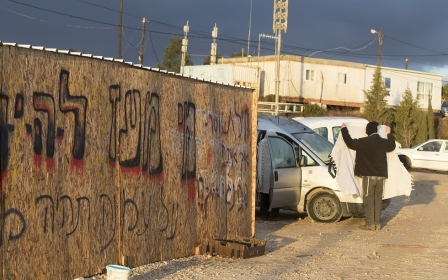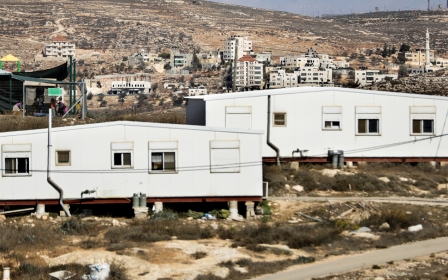Israeli settlements and Palestinians: Even the 'moderates' want segregation

The settlers of the Amona outpost are but a tiny fraction of the hundreds of thousands who live in colonies, established by Israel in the occupied Palestinian territory since 1967. Their fate has seen Benjamin Netanyahu challenged by the pro-settler right both inside and outside his coalition government.
For some, the fact that the court-mandated removal of settlers living on privately owned Palestinian land is taking place at all proves that Israel is not, in fact, being led by the "settler lobby".
As one columnist put it in Haaretz, “the man who just a week [ago] declared that he continues to support the two-state solution has proven he will fold like an accordion under pressure from 40 families in a single illegal outpost in the middle of nowhere. So how exactly will he evacuate 100,000 Jews from their homes in isolated settlements?”
Hope for real change?
Meanwhile, a law is advancing in the Knesset that would see a whole-scale, post-facto "legalisation" of Israeli outposts built on private Palestinian land. Some see this as part of a creeping (or perhaps accelerating) process of annexation of swathes of the West Bank.
In European capitals – even in Washington – diplomats and politicians are increasingly concerned about an Israeli government dominated by individuals and political tendencies who either explicitly reject Palestinian statehood, or who are only too happy to boost West Bank settlements.
'We need to remove the Palestinians from our lives – we need to do this by building a high wall and making them disappear'
- Yair Lapid, Yesh Atid leader
But what if, somehow, Netanyahu was toppled in the next election, which must be called by 2019? What if his coalition proves too unstable and, amid all the political debris, the extreme right is removed from power? What then? Would an Israeli government headed by, say, Yair Lapid or Isaac Herzog, offer a hope of real change – and a genuine peace deal with the Palestinians?
Unfortunately, the answer is a resounding no. While the likes of education minister Naftali Bennett and others have loudly reiterated their opposition to a two-state solution since Donald Trump’s election victory, Yesh Atid leader Lapid has also been busy promoting his vision of peace, which he recently summarised on Israeli television.
“We need to remove the Palestinians from our lives – we need to do this by building a high wall and making them disappear," he declared. Or, as another translation put it: “Get them [the Palestinians] out of our sight.” This is familiar stuff: a year ago, Lapid declared: “We need to separate from the Palestinians and to make sure there’s a higher wall between us – not a smaller wall.”
Devil in the details
But what about the details? Well, according to Lapid, while he “support[s] the idea of a two-state solution”, he also insists that “Jerusalem will not be divided and will remain the capital of Israel". That’s not his only overlap with Netanyahu – “both men insist… that the Israel Defense Forces will need to retain a long-term presence throughout the West Bank".
Lapid has also advocated a freeze in settlement construction “outside the big blocs in order to build inside them". Earlier this year, Lapid specifically named the Ma’ale Adumim, Ariel and Gush Etzion so-called settlement "blocs", and asserted that Ma’ale Adumim – which lies east of Jerusalem and almost divides the West Bank in two – “will always be a part of Israel".
READ: Israel on the fast track to West Bank annexation
Then there’s Isaac Herzog, Labor party leader, and head of the opposition Zionist Camp. This year, he announced that a two-state solution was not possible for the time being and called for separation from the Palestinians by completing the separation wall around the settlement "blocs" in the West Bank. “I want to separate from as many Palestinians as possible, as fast as possible," Herzog said.
It is unclear which "blocs" Herzog meant – though like Lapid, he has previously named Ma’ale Adumim, Ariel and Gush Etzion. The Zionist Camp’s last manifesto vowed that any “final status agreement” with the Palestinians would include Israeli annexation of “the settlement blocs in Judea and Samaria [the West Bank]”, with Jerusalem remaining “the eternal capital of the State of Israel".
Make no mistake, the so-called "settlement blocs" are as much – or even more – of an obstacle to the establishment of a Palestinian state in the West Bank as the "wildcat" outposts. Naftali Bennett and Ayelet Shaked may get the headlines for their brand of rejectionist nationalism but Herzog likewise is dedicated to ensuring that Jerusalem will “remain Jewish” and “whole”.
The options on the table
The Israeli right, as represented by Netanyahu, wants the status quo for as long as possible, a permanently temporary occupation. The Israeli right of Bennett wants to take the necessary steps, such as annexation of all or part of the West Bank, to create a single, defiantly apartheid state.
READ: Israel should face ICC over illegal settlement bill
The Israeli centrists, the "moderate" opposition represented by Lapid, Herzog and Tzipi Livni, want segregation and “separation” through the form of a Palestinian Bantustan state: in Yitzhak Rabin’s words, “an entity which is less than a state".
The international community must understand that these are the options on the table. Amona is no less fatal for a Palestinian state than Ariel – and the latter enjoys political support well beyond the "hilltop youth" and settler activists.
Ben White is the author of Israeli Apartheid: A Beginner’s Guide and Palestinians in Israel: Segregation, Discrimination and Democracy. He is a writer for Middle East Monitor and his articles have been published by Al Jazeera, al-Araby, Huffington Post, The Electronic Intifada, The Guardian's Comment is Free and more.
The views expressed in this article belong to the author and do not necessarily reflect the editorial policy of Middle East Eye.
Photo: A file photo of a settlement being built (AFP)
Middle East Eye propose une couverture et une analyse indépendantes et incomparables du Moyen-Orient, de l’Afrique du Nord et d’autres régions du monde. Pour en savoir plus sur la reprise de ce contenu et les frais qui s’appliquent, veuillez remplir ce formulaire [en anglais]. Pour en savoir plus sur MEE, cliquez ici [en anglais].






